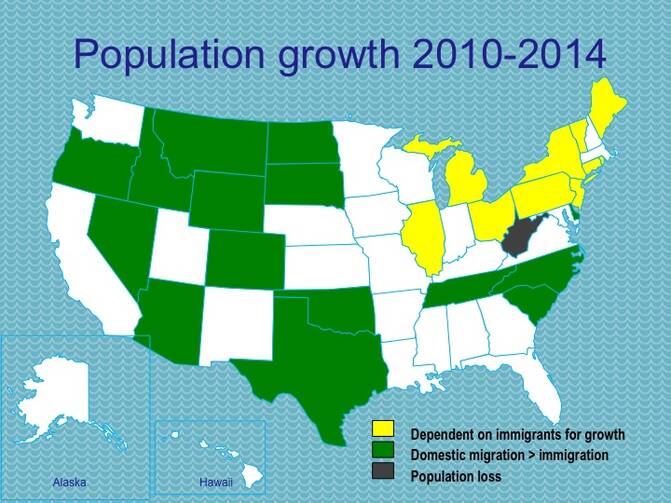It was Christmas in December for demographers last week, as the U.S. Census Bureau released its annual estimates of each state’s population. The big news was Florida passing New York to become the third-largest state—thanks, in part, to the 8 percent of Florida residents who were born in New York. Meanwhile, the Census Bureau estimated population losses from 2013 to 2014 in Alaska, Connecticut, Illinois, New Mexico, Vermont, and West Virginia.
The Census data also include the causes of each state’s population gain or loss, and immigration has had much different effects in different states.
Ten states in the Northeast and Great Lakes regions would have suffered population losses during the four-year period from 2010 to 2014 if not for immigrants. (Shown in yellow on the accompanying map, they are Connecticut, Illinois, Maine, Michigan, New Jersey, New York, Ohio, Pennsylvania, Rhode Island, and Vermont.) If not for immigration, these states would have significantly less economic activity, fewer young taxpayers to keep government afloat, and even bigger losses in the House of Representatives and Electoral College than they already face. Policymakers in those states, if not necessarily voters, are likely to applaud President Obama’s executive action shielding millions of undocumented migrants from deportation.
In 15 states, mostly in the West, citizens poached from other states accounted for more growth than did immigration. (Shown in green on the accompanying map, they are Arizona, Colorado, Delaware, Idaho, Montana, Nevada, North Carolina, North Dakota, Oklahoma, South Carolina, South Dakota, Tennessee, Texas, and Wyoming, plus the District of Columbia.) Because these states would be growing even without new residents from abroad, they may be more likely to support restrictive immigration policies. Arizona and Texas, indeed, are known for anti-immigration activism. Ironically, it may be native-born Americans from the East, more than immigrants, who are driving the demand for new housing and putting new strains on infrastructure in those states.
The fact is, Americans just don’t like to move to most of America. Only 21 states registered a net gain in domestic migration from 2013 to 2014, with Florida and Texas each gaining more than 100,000 Americans who were born in other states. New York lost 154,000 residents to other states, avoiding a net loss because of 86,000 births and 119,000 new residents from abroad.
Several magnets for large numbers of native-born Americans—not only Florida and Texas, but also Arizona, Colorado, and Nevada—are already among the most urbanized states in the U.S. The cherished ideal of small-town America is more common in the Appalachians and the Ohio River Valley than in Western states where almost everyone is crammed into a few counties. One result may be greater political tension between densely populated mega-regions, trying to manage growth, and small cities and towns seeking help from the federal government in rejuvenating their economies. (Also see "How Big Can America Get Before Its Political System Starts to Buckle?")
The patterns of population growth in the U.S. seem to be in a rut that may last longer than the red vs. blue political schism. Most states have consistently grown faster or slower than the national average for several decades. In the map below, states that have outpaced the national average in 1990, 2000, 2010, and so far this decade are in purple. They are generally characterized by warm weather, cheap land, and modern infrastructure. States that have consistently lagged behind the national average are in orange. Most are in the Northeast or Midwest, and have historically been dependent on manufacturing (or “Rust Belt”) industries.
You might wonder whether the “back to the city” movement will change the colors on this map. It’s true several older cities are on a rebound. New York, Chicago, Philadelphia, and Boston have grown so far this decade, and white-collar cities like Columbus, Ohio, continue to thrive in the middle of the Rust Belt. But smaller cities that have not been able to transition to a post-industrial economy are not part of this revival. The decade so far has seen continued population losses in such cities as Buffalo, New York; Rockford, Illinois; Scranton, Pennsylvania; Fall River, Massachusetts; and Youngstown, Ohio.
These areas with low or negative population growth are in a double bind. They are losing political influence in states that are themselves losing power in Washington, D.C. They have good reason to fear that their concerns won’t get much attention in the next presidential election.
Map templates from Presentation Magazine.









